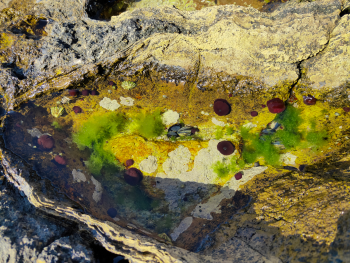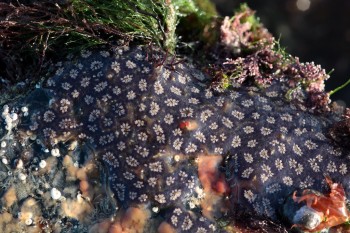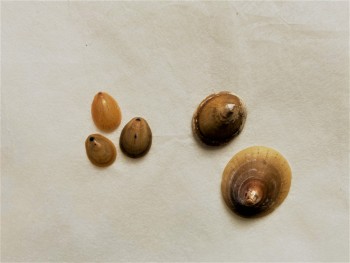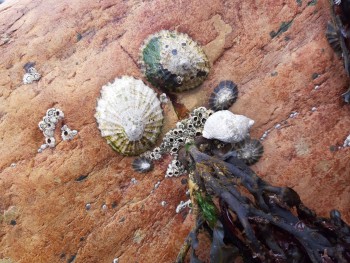As shell collectors it is easy to forget that shells are only one part of the molluscs and that they are only the protection for the delicate animals within. Molluscs have been a source of food for humans for thousands of years, stretching back to the Mesolithic period where rubbish piles (middens) full of mollusc shells provide some of the only evidence that those migratory people inhabited an area. The Romans famously had a taste for oysters and many archaeological excavations from that period uncovered large quantities of their shells. This love of oysters has persisted into the modern day as well as a large demand for mussels, clams and other shellfish.
It is easy to only concern ourselves with what shellfish provide for us, but it is interesting to think on what they themselves consume in order to survive in our oceans and seas. Many different species of mollusc reside in Orkney’s waters with various different diets.
Bivalves (such clams and mussels) are filter feeders. Identifiable by their two sides (valves) connected by a hinge, many bivalves attach themselves to rocks with strong threads called byssus threads. Other species of bivalves such as the sand gaper or the razor calm (locally known as spoots) often live in large communities burrowed into the sands or silts. From their holdfasts or burrows, these species can filter the sea water through their valves and absorbs nutrients as well as consuming small living things like planktons.

Gastropods are also very varied in their diets. Many are grazers, feeding on algae, seaweeds and other stationary sea life. The famous groattie buckie, for example, feeds on ascidians and sea squirts. The species Botryllus schlosseri also known as the star tunicate, grows in clusters and has very distinct star shape that often resembles constellations.

Many other species, such as the blue rayed limpet and its sibling Patina laevis - or as Robert Rendall named it in his 1955 publication ‘Mollusca Orcadensia’, the pellucid limpet - reside in close quarters with their food source. Primarily, these species feed on the Laminaria family of seaweeds, commonly recognised as kelp which is abundant in Orkney’s water. On the fronds or leaves of Laminaria the blue rayed limpet can often be found with its electric blue stripes glinting in the light shining through the water. The pellucid limpet, which lacks the highly identifiable blue stripes, can be found further down, in the frond’s shadow among the seaweed’s holdfasts.
A seaweeds holdfast is a similar structure to the roots of a tree but rather than gathering nutrients, its only function is to hold the seaweed firmly in place.

However, not every mollusc feeding pattern is quite so gentle. Some are carnivores. Dog whelks are the classic example of this dietary behaviour, feeding on its fellow molluscs. Limpets are one of their food sources and often, when you find limpet shells washed ashore, they will have a small hole in them. The dog whelk bores this small hole into the shell of its prey then injects a narcotic to relax the animal within. It then essentially digests the animal within its own shell using various enzymes the whelk can secrete and sucks up the liquid soup. While this may not create much fear in humans, for molluscs, species such as the dog whelk represent vicious predators.

While looking at the shells we can find on the beaches around Orkney, it is interesting to about the dietary habits of these animals are as varied and interesting as our own.




